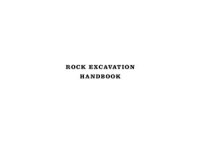
Ebook: Rock Excavation Handbook
Author: Heiniö Matti.
- Genre: Geology // Mining
- Tags: Горно-геологическая отрасль, Буровзрывные работы
- Language: English
- pdf
Sandvik Tamrock Corp., 1999. — 364 p.Excavation activities at construction sites are very diverse. Contracting customers also vary significantly in size. What is a typical construction project made up of? The answer is that all construction projects are time-limited. Project duration varies from one month to several years, and the schedules are almost always tight. Usually, immediate mobilization takes place once the contract has been awarded and often there are penalties involved if the original schedule does not keep. It is therefore important to choose the right excavation method together with the right equipment to keep the project on schedule. This handbook covers all modern excavation methods and also provides some recent case stories.
Excavation methods can be divided into groups. The following classification shows how it is handled in this book.
Both aggregate and limestone quarrying by the drill & blast method and mechanical method is discussed in the chapter called Quarrying.
General contracting includes a wide range of projects from rock foundation in buildings and roads to channel excavation in dams, road cuttings etc. Underwater excavation is also included in this section.
Today, demolition and recycling play an important role and are discussed in detail in the chapter on general contracting.
In the Tunneling chapter, which also includes underground excavation, both traditional drill & blast and mechanical method are discussed. Underground excavation varies significantly from sewage tunnels and powerhouses to railway and highway tunnels as well as from warehouses and parking halls to theaters, swimming pools and ice-hockey halls.
Dimensional stone quarrying is explained according to each method in use.
The last chapter concerning excavation methods describes water well and exploration drilling.
The final chapter is dedicated to project management. It describes issues that should be considered and remembered when handling an excavation project. Last but definitely not least is
service support.
At the end of every chapter, there is a case description providing a real-life example of a typical excavation site.
Excavation methods can be divided into groups. The following classification shows how it is handled in this book.
Both aggregate and limestone quarrying by the drill & blast method and mechanical method is discussed in the chapter called Quarrying.
General contracting includes a wide range of projects from rock foundation in buildings and roads to channel excavation in dams, road cuttings etc. Underwater excavation is also included in this section.
Today, demolition and recycling play an important role and are discussed in detail in the chapter on general contracting.
In the Tunneling chapter, which also includes underground excavation, both traditional drill & blast and mechanical method are discussed. Underground excavation varies significantly from sewage tunnels and powerhouses to railway and highway tunnels as well as from warehouses and parking halls to theaters, swimming pools and ice-hockey halls.
Dimensional stone quarrying is explained according to each method in use.
The last chapter concerning excavation methods describes water well and exploration drilling.
The final chapter is dedicated to project management. It describes issues that should be considered and remembered when handling an excavation project. Last but definitely not least is
service support.
At the end of every chapter, there is a case description providing a real-life example of a typical excavation site.
Download the book Rock Excavation Handbook for free or read online
Continue reading on any device:

Last viewed books
Related books
{related-news}
Comments (0)